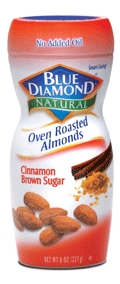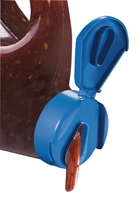
The hinged closure on this Blue Diamond almonds jar can be opened with one hand, a plus for on-the-go consumers.
To meet the needs of mobile consumers, as well as the full age range of users, ergonomic design is playing a prominent role.
“Several target audiences are driving the increased emphasis on ergonomics: aging consumers, children, people on the go,” says Jane Haywood-Rollins, global marketing services manager with Closure Systems International (CSI). Formerly a unit of Alcoa Inc., CSI recently was acquired by the New Zealand-based Rank Group Limited.
In addition, companies are “continually seeking ways to enhance consumer satisfaction, and more convenient, easier-to-open packaging can be a point of differentiation,” Haywood-Rollins says.
Creating knurl designs that are easy to grip is one approach to closure ergonomics. Another is the use of thermoplastic elastomer (TPE) resins, which are soft-touch plastics that enhance gripping.
The closure on Kraft’s Maxwell House EZ Grip instant coffee incorporates TPE to make it easier for the product’s target audience, seniors, to open and securely reclose the wide-mouth glass jar. The 70-millimeter closure, supplied by CSI, earned an Ease of Use Commendation from the Arthritis Foundation.
To meet the special needs of children, dispensing closures that provide better control of product flow are a promising area. In consumer focus groups, Weatherchem Corp. discovered that liquid products like salad dressing are a particular problem for kids, because they can’t control dispensing. Too often, parents reported, their kids end up with a salad bowl full of dressing.
To make it easier to control the flow of liquid products, Weatherchem developed the LiquiFlapper closure system. This dispensing cap limits flow somewhat, providing control for kids and others with limited manual dexterity, but at the same time provides enough flow for able-bodied adults. The closure is drip resistant and has a cut-off feature that eliminates mess and waste.
For on-the-go consumers, especially those who snack as they drive, closures designed for one-handed opening and mess-free dispensing are in demand. The lid on the Blue Diamond Natural Oven Roasted Almonds package, for example, is a hinged dispensing closure that can be opened easily with a flick of the thumb.
The polypropylene closure features rounded contours that both aid in opening and visually complement the curves of the easy-to-grip, nipped-waist container. The lid, a 63mm, single-flap Flapper closure from Weatherchem, provides an audible snap to confirm secure reclosing. A foil seal safeguards freshness until the 8-ounce container is opened, and a full-body shrink label provides tamper evidence.

Weatherchem's LiquiFlapper closure is designed to control the flow of liquid products.
The green factor
With sustainability under constant scrutiny, closure suppliers have found that lightweighting is one of the most practical ways to reduce a closure’s environmental footprint.Rexam Closures has developed a line of ultra-light hinged dispensing closures that feature a variety of dispensing orifices. These closures are expected to go into production early next year.
“The new, lighter 33mm design reduces the weight by over 20% compared to the current design. This is accomplished without requiring a bottle finish change or significantly affecting the functionality of the closure,” reports Dallas Stiles, director of global food and dairy at Rexam Closures.
Weatherchem also puts a strong emphasis on lightweighting. “All our new closures are 10% to 20% lighter than previous iterations. We put extra effort into reducing material weight,” says Anna Frolova-Levi, director of marketing at Weatherchem.
For CSI, reducing the height of standard beverage closures has been a focus in recent years. The company’s short-height Mini closures lightweight beverage packages in two ways: by making the closure smaller and by reducing the height and weight of the bottle’s neck finish.
According to CSI, by using the short-height 1873 PCO bottle finish and the Xtra-Lok Mini closure, beverage producers can realize up to 1.8 grams of package weight savings compared with using the 1810 PCO bottle finish with a standard height closure.
“We are working with a number of beverage companies as the shift from standard height closures to short closures begins to accelerate,” says John Grainda, CSI’s global marketing manager.
A major benefit of the trend is source reduction. “We are able collectively to use less material,” Grainda says. “It’s a big opportunity to help sustainability initiatives.”
Bericap, which markets SuperShorty lightweight plastic closures for carbonated beverages, has calculated the extent to which replacing a traditional plastic carbonated soft drink closure with a shorter, lighter closure and lighter neck finish reduces carbon footprint.
In the calculations, the traditional closure weighs 3.2g and is paired with a PCO 1810 polyethylene terephthalate (PET) neck finish weighing 5.05g. The new closure weighs 2.4g and is paired with the PCO 1881 PET neck finish weighing 3.82g. Both closures are 28mm.
Bericap calculates that replacing the old with the new on 500 billion bottles, the world market estimate for beverages, would save 1 million tons of resins and 7.5 million tons of carbon dioxide-equivalent emissions.
Lightweighting liners or eliminating them altogether are additional areas of interest for source reduction. Weatherchem supplies linerless closures for spices, seasonings and other products that do not require a seal for freshness, and the company currently is developing a linerless LiquiFlapper for liquid products.
For aseptic beverage packages, Rexam has developed an all-plastic, tamper-evident barrier cap, the SecurSeal Closure, which eliminates the need for a separate foil seal.
Barrier closures
Ensuring barrier properties in closure systems is another emphasis of research and development, with molded-in barrier liners gaining ground.Rexam’s Therma Closure, for retorted foods and beverages, was designed with a barrier liner molded into the cap. And the company’s EasySeal HT Closure, designed for dressings, fruit, relish and pickles, offers barrier and non-barrier molded-in liner options.
A completely different style of barrier closure is CSI’s Vino-Lok stopper for wine. The closure system incorporates a glass stopper, food-grade polymer seal and aluminum capsule to protect wine from random oxidation. Cork taint and product leakage also are eliminated.
A special neck finish on the wine bottle assures appropriate sealing. The stopper is used commercially in Europe, and a number of U.S. wineries have tested marketed the glass stopper or are using it on a small scale.
Thanks to these kinds of innovative solutions, closure technology continues to surprise us even as it addresses practical needs.F&BP
Kate Bertrand Connolly is a freelance writer based in the San Francisco Bay area, who specializes in packaging, business and technology. Reach her at kate.connolly@sbcglobal.net.
FOR MORE INFORMATION
Bericap909-390-5518
Closure Systems International (CSI)
800-311-2740
Design North
262-898-1090
Rexam
567-336-8411
Weatherchem Corp.
800-680-3412

Target has revolutionized cereal packaging using a paperboard canister topped with a dispensing closure.
SIDEBAR: Where no closures have gone before
Target Brands Inc. is changing the way consumers think about cereal with a new package for its private-label Archer Farms ready-to-eat cereal that incorporates a dispensing closure.The package, introduced in April 2008 exclusively in Target and SuperTarget stores, consists of a foil-sealed paperboard canister topped with a recloseable, snap-shut lid designed for no-mess dispensing.
“There’s a spout so you can pour your cereal more easily. It’s a well done package both graphically and structurally. You get the added bonus of resealability and pourability,” says Lee Sucharda III, president of Design North, a package design firm. (Design North did not work on this project with Target but did do some consumer research about the package.)
The oblong-shaped canister, which is made partially from recycled paperboard, has a slim profile, measuring 10 inches tall by 21/2 inches deep. According to Target, the new package design ensures that the cereal stays fresher longer.
Archer Farms canister cereal is available in 18 flavors, including Triple Berry Clusters, Vanilla Spice Squares, Banana Walnut Bliss, Pecan Sticky Bun and Blueberry Flax. Pricing is $3.49 to $3.99.
